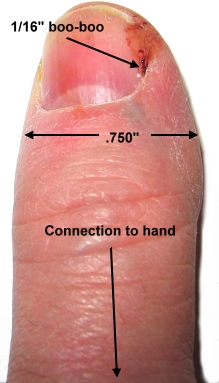
Whew! These articles don’t come without some serious sacrifice. A few hundred rounds of ammo through the new Winchester and I was left almost totally disabled. I’ve had M1 thumb, I’ve never had Model 94 thumb…until now. The only reason I’m mentioning the injury here is because my wife said if I persisted in whining to her about what she referred to as “that scratch”, she would begin referring to me as “Fancy Lad”, as in, “When did you become such a Fancy Lad?”. More to the point….
The Winchester Model 94 is clean in appearance, but it was not what I would call a slick functioning rifle, even after 300+ rounds. The lever activated safety was annoying at best. The trigger pull had a lot of creep, and after 50 rounds the feel deteriorated to something akin to cracking bricks. Cartridges needed a lot of effort to be forced into the magazine; I couldn’t imagine loading cartridges in the field while wearing gloves. The gate retention spring force is excessive and side pressure applied directly to the cartridge rim was required to clear the feed opening. In addition, the inside surface of the opening in the receiver is sharp edged, causing cartridges to not want to feed into the magazine and the afore mentioned thumb affliction. Once loaded, extraction, ejection and feed were flawless, regardless bullet type or C.O.L.. And, yes, I am familiar with lever action rifles, the Winchester is one of three I currently own. On the other hand, the other billion people who have purchased and used the Model 94 can’t be all wrong. Maybe I am becoming a fancy lad?
The Range
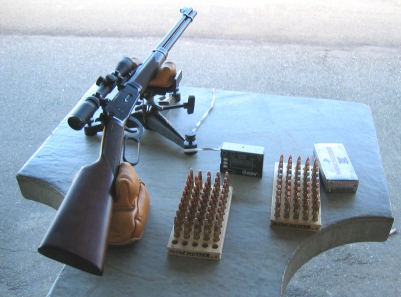
Excellent range day; clear skies, good company, nice people. If you are in the Saratoga, CA area, I highly recommend the Los Altos Rod and Gun Club. The hours and days of operation, as well as pictures of the facilities are on their web site. Temperature was about 62° F, still air and 65% humidity.
I’m pretty sure I could have shot the rifle all day without a barrel meltdown, unlike my Weatherby rifles that allow a hungry shooter to cook toasted cheese sandwiches on the fluted barrels after 4 or 5 rounds are fired in quick succession. Still, I did find a practical limit of 10 rounds in relatively rapid success before the gun required a quick few minute cool down to avoid vertical stringing. Unless participating in a Little Big Horn reenactment, or a fan of Chuck Conner’s, 5 rounds in rapid succession with predictable shot placement is probably more than enough. I brought along 3 types or models of .30-30 WCF firearms, and a couple of boxes of factory ammo to establish some points of comparison.
X Marks the Spot – Mag Primers Make a Difference
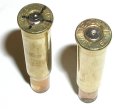 I did assemble and test fire several loads, a mixture of light and dense case filling, to see what the difference would be when alternating between magnum and standard large rifle primers with all else remaining the same. The details of this testing will appear in a near future article, but I thought the basic results were interesting.
I did assemble and test fire several loads, a mixture of light and dense case filling, to see what the difference would be when alternating between magnum and standard large rifle primers with all else remaining the same. The details of this testing will appear in a near future article, but I thought the basic results were interesting.
| Bullet | Weight | Powder | Charge | Std Primer fps | Mag Primer fps | Δ |
| Sierra | 150 | Win 748 | 36.5 | 2390 | 2417 | +27 |
| Sierra | 150 | Re 15 | 36.4 | 2239 | 2404 | +165 |
| Sierra | 150 | IMR 3031 | 34.5 | 2318 | 2465 | +147 |
At least when bullets are securely crimped, magnum primers seem to increase average pressure. At first I thought this difference was proportional to the degree of case filling, but that is not the case. Looking at a more broad representation of samples than appearing on this page, stick powder appears to be effected more than ball powder, regardless burn rate, however, slower stick powder seems to change more dramatically than faster stick powder. Beyond conjecture, I could not explain the dynamic that caused the pressure change. The velocity or pressure increase indicative of more complete and rapid ignition, it could also be the increase in the primer charge generate greater pressure independent of the effect on the powder charge, or even the increased primer generated pressure driving the powder charge against the bullet base and then the bullet into the rifling leade prior to powder ignition; a pressure spike from a bullet seated on the rifling. I don’t know why, but I know substitution makes a significant difference.
Through calculation, not pressure testing, the minor difference in velocity caused by the switch suggests a 1,640 PSI average pressure difference. The largest velocity change represents the equivalent of a 10,000 PSI pressure change, or a full 2.5 grains of Reloder 15, just by interchanging magnum and standard primers.
Short Barrel – Longer Barrel
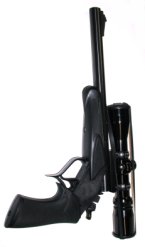 I brought along a 14″ T/C Contender and my Marlin 336. Both rifles have 20″ barrels and there wasn’t enough difference in velocity performance to note, beyond saying the Marlin gave up about 15 fps to the Winchester. The degree of difference between Winchester and Contender varied, but in a way that was predictable. The slowest powder, Hodgdon BL-C(2) rounds produced as much as 280 fps greater velocity in the Winchester with heavy 170 grain bullets. The same powder, but with a Barnes 150 grain and uniform charges generated 100 fps more velocity from the Winchester over the T/C. Cast 170 grain bullets and IMR 3031 were only 60 fps or so faster out of the rifle barrel.
I brought along a 14″ T/C Contender and my Marlin 336. Both rifles have 20″ barrels and there wasn’t enough difference in velocity performance to note, beyond saying the Marlin gave up about 15 fps to the Winchester. The degree of difference between Winchester and Contender varied, but in a way that was predictable. The slowest powder, Hodgdon BL-C(2) rounds produced as much as 280 fps greater velocity in the Winchester with heavy 170 grain bullets. The same powder, but with a Barnes 150 grain and uniform charges generated 100 fps more velocity from the Winchester over the T/C. Cast 170 grain bullets and IMR 3031 were only 60 fps or so faster out of the rifle barrel.
All of the loads appearing here, and in the .30-30 WCF rifle section also performed without a hitch in my Contender and Marlin. Even after a lot of use, the Contender still functions without problems, and it is very accurate and easy to shoot. Because of its size, I’m not sure exactly how much handier it is to carry in the field than a carbine, but it is a lot of fun to shoot and it can produce 2,000 fps performance with 150 and 170 grain bullets, from a 14″ barrel, with the right combination of components.
Factory Ammunition
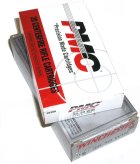 For the sake of comparison, some factory wonder ammo was fired, “Wonder” as in, “I wonder what happed to all of those feets per second?” Winchester Super X 150 grain Power Point loads fell over 100 fps shy of the advertised velocity of 2,390; producing on the average 2,282 fps. PMC’s rated 2,300 fps 150 grain Bronze Line ammo was closer to advertised performance with 2,260 fps. The recorded velocity difference between the Chrony and Oehler chronographs was insignificant and correction to recorded distances was made to account for the start screen placement 10′ from the test gun’s muzzle. Is there the possibility the factory collected this data from a 24″ barrel firearm? Yes, of course, but that would be inappropriate as there are few firearms chambered for the .30-30 WCF with a barrel longer than 20″.
For the sake of comparison, some factory wonder ammo was fired, “Wonder” as in, “I wonder what happed to all of those feets per second?” Winchester Super X 150 grain Power Point loads fell over 100 fps shy of the advertised velocity of 2,390; producing on the average 2,282 fps. PMC’s rated 2,300 fps 150 grain Bronze Line ammo was closer to advertised performance with 2,260 fps. The recorded velocity difference between the Chrony and Oehler chronographs was insignificant and correction to recorded distances was made to account for the start screen placement 10′ from the test gun’s muzzle. Is there the possibility the factory collected this data from a 24″ barrel firearm? Yes, of course, but that would be inappropriate as there are few firearms chambered for the .30-30 WCF with a barrel longer than 20″.
None of the preceding information is earth shattering news, however, it is important information when striving to produce handloads that out perform factory fodder. For the purposes of this article, I thought this insight might eliminated the chance of an apple to pineapple comparison. Factory ammo is fine. The cheap stuff, with the exception of the benefits of premium bullet construction, will probably perform as well as expensive factory premium brands. Handloads should provide increased velocity and premium bullet construction, at inexpensive factory brand prices.
RCBS.Load
I use RCBS.Load frequently. Beyond its more pedestrian exterior ballistic calculations capabilities which it handles so well, there are lots of other useful tools included for shooters and handloaders, like a real time cartridge designer and a multiple source handload data source. In the context of this article I used the program’s Target Tool function to analyze and store group size information. All I had to do was drop the target on an inexpensive scanner, hit the scan button in the RCBS.Load menu, then click on the bullet holes with the computer mouse pointer to get true center of mass group size calculation. Rather than measure the distance between the centers of the farthest holes, center of mass identifies the statistical center of the group, then measures the distance from that center to the farthest hole. Essentially the suggestion is that movement from the typical shot placement has more bearing on accuracy than the two outside shot placement extremes. The author’s site explains the product, but does not sell direct. I still think the features of RCBS.Load are some of the best kept secrets in the industry. No, I get nothing for mentioning the product, but at a time when advertising dollars rather than value seem to make products successful, I thought I should speak up for something that works.
Handload Results
 The Model 94 was sensitive to bullet types and weight, much more so than powder type and specific charge; if a bullet shot well with Win 748, it probably shot well with Benchmark. However, velocity did vary a good deal with powder selections. Based on this range outing, it was easy to come up with a preferential list of bullets and powder. As a 3 shot string rifle, the Winchester was great. As a 5 or more shot rifle, vertical and horizontal stringing was typical, sometimes more than doubling group sizes. For example, The 170 grain Sierra placed three shots in .7″, then opened up to 1.2″ on the fourth shot, then a full 3.1″ on the fifth shot. As a practical matter, I would be placing more emphasis on a three shot group for hunting, the 5 shot groups would be more meaningful for other applications.
The Model 94 was sensitive to bullet types and weight, much more so than powder type and specific charge; if a bullet shot well with Win 748, it probably shot well with Benchmark. However, velocity did vary a good deal with powder selections. Based on this range outing, it was easy to come up with a preferential list of bullets and powder. As a 3 shot string rifle, the Winchester was great. As a 5 or more shot rifle, vertical and horizontal stringing was typical, sometimes more than doubling group sizes. For example, The 170 grain Sierra placed three shots in .7″, then opened up to 1.2″ on the fourth shot, then a full 3.1″ on the fifth shot. As a practical matter, I would be placing more emphasis on a three shot group for hunting, the 5 shot groups would be more meaningful for other applications.
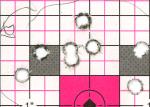 150 grain Sierra bullets, regardless powder type and load, didn’t fare as well, with a groups size of 3.5″. Probably of greater consequence was that the group was strung out horizontally with 4″ the extreme spread. I tried this bullet several times and was unable to find a load combination that performed better. The Speer 150 grain (Left) was good for 8 shots in 1.5″ with an extreme spread of 2″ and wasn’t sensitive to powder type or charge. The Barnes XFP 150 grain bullet grouped at 1.8″ for 5 shots, the extreme spread was 2.5″. Remington 150 grain bullets groups almost identical to Barnes.
150 grain Sierra bullets, regardless powder type and load, didn’t fare as well, with a groups size of 3.5″. Probably of greater consequence was that the group was strung out horizontally with 4″ the extreme spread. I tried this bullet several times and was unable to find a load combination that performed better. The Speer 150 grain (Left) was good for 8 shots in 1.5″ with an extreme spread of 2″ and wasn’t sensitive to powder type or charge. The Barnes XFP 150 grain bullet grouped at 1.8″ for 5 shots, the extreme spread was 2.5″. Remington 150 grain bullets groups almost identical to Barnes.

This Hornady 170 grain group was .2″ for 4 shots, then opened to 1.3″ with the 5th shot. In general, the heavier 170 grain bullets grouped much tighter. Hornady tends to offer a good value in bullets. They seem always uniform in weight and size in production, the jacket construction is good, and they tend to group well. Another benefit of using Hornady is price, they are one of the most reasonably priced quality bullets out there, which allows a lot of shooting without a lot of expense. I’m also growing to like the Hornady Dies with Sliding Inline Seating System. It contacts bullets in the right place on the ogive and saves on buying multiple seating plugs for different bullet contours.
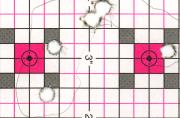 The little 110 grain Hornady bullets averaged 2.5″ 5 shot groups over a selection of 7 variations of loads; about what I anticipated. Not exciting, but also not bad for a .30-30 WCF with light bullets. Velocity was a little lower than comparable reloading data would suggest, but this was an easy round to shoot, particularly when loaded to lower velocities with powder selections more appropriate for a magnum powder. I did not use any filler with any of these light loads and did not experience an signs of odd pressure results or improper ignition. They were easy on the ears.
The little 110 grain Hornady bullets averaged 2.5″ 5 shot groups over a selection of 7 variations of loads; about what I anticipated. Not exciting, but also not bad for a .30-30 WCF with light bullets. Velocity was a little lower than comparable reloading data would suggest, but this was an easy round to shoot, particularly when loaded to lower velocities with powder selections more appropriate for a magnum powder. I did not use any filler with any of these light loads and did not experience an signs of odd pressure results or improper ignition. They were easy on the ears.
The table below summarizes handload performance results. I will be updating the .30-30 WCF Rifle table in the handload section and include the specifics of C.O.L., primer selection and groups size. The bold txt denotes the most accurate. When I put up the handload table I will note the 3 shot group measurement, rather than groups with a larger number of shots fired to be consistent with other data appearing within that section.
| Powder | Rem 150 | Rem 170 | Sierra 150 | Sierra 170 | Speer 150 | Barnes 150 | Nosler 170 | Win 150 | Hrndy 110 | Hrndy 170 | TruShot 170 |
| BL-C(2) | 36.0 | 34.0 | 36.5 | 34.0 | 36.0 | 33.5 | 34.0 | 36.5 | 39.0 | 34.3 | 34.5 |
| fps | 2260 | 2046 | 2209 | 2036 | 2285 | 2160 | 2049 | 2199 | 2543 | 2129 | 2109 |
| Win 748 | 35.7 | 33.8 | 36.1 | 33.7 | 35.8 | 33.0 | 33.4 | 35.8 | 37.5 | 33.7 | 33.5 |
| fps | 2263 | 2107 | 2237 | 2061 | 2399 | 2194 | 2059 | 2235 | 2528 | 2111 | 2156 |
| Varget | 34.6 | 32.7 | 35.0 | 32.5 | 34.7 | 32.1 | 32.4 | 34.7 | 37.5 | 32.7 | 32.9 |
| fps | 2235 | 2062 | 2210 | 2013 | 2234 | 2120 | 2041 | 2171 | 2549 | 2190 | 2103 |
| Re 15 | 36.0 | 34.0 | 36.4 | 33.9 | 36.0 | 33.3 | 33.6 | 36.1 | 38.0 | 33.9 | 34.1 |
| fps | 2253 | 2050 | 2239 | 2091 | 2312 | 2138 | 2059 | 2226 | 2419 | 2147 | 2165 |
| TAC | 33.5 | 31.5 | 33.7 | 31.4 | 33.4 | 31.0 | 31.1 | 33.4 | 36.5 | 31.4 | 31.6 |
| fps | 2229 | 2089 | 2278 | 2091 | 2289 | 2101 | 2090 | 2278 | 2556 | 2113 | 2153 |
| Benchmark | 33.5 | 31.8 | 34.0 | 31.6 | 33.7 | 31.0 | 31.2 | 33.6 | – | 31.6 | 32.0 |
| fps | 2402 | 2192 | 2349 | 2210 | 2409 | 2193 | 2154 | 2334 | – | 2187 | 2169 |
| IMR 3031 | 34.0 | 32.1 | 34.5 | 32.0 | 34.0 | 31.5 | 31.8 | 34.0 | – | 32.1 | 32.2 |
| fps | 2409 | 2204 | 2318 | 2191 | 2388 | 2184 | 2168 | 2306 | – | 2195 | 2085 |
| IMR 4895 | 34.0 | 32.4 | 33.3 | 32.0 | 33.0 | 32.0 | 32.3 | 33.2 | 35.0 | 32.5 | 22.0 |
| fps | 2207 | 2206 | 2137 | 2212 | 2280 | 2301 | 2116 | 2208 | 2341 | 2016 | 1525 |
| Re 7 | 30.0 | 28.0 | 29.5 | 27.5 | 29.3 | 26.8 | 27.7 | 29.3 | 32.5 | 27.3 | 23.0 |
| fps | 2232 | 2184 | 2191 | 2155 | 2332 | 2236 | 2169 | 2297 | 2554 | 2134 | 1930 |
| Win 296 | – | – | – | – | – | – | – | – | 19.0 | – | 20.0 |
| fps | – | – | – | – | – | – | – | – | 1846 | – | 1804 |
| H110 | – | – | – | – | – | – | – | – | 22.0 | – | 13.5 |
| fps | – | – | – | – | – | – | – | – | 2084 | – | 1509 |
Primers were very slightly cratered coming out of the Winchester, but there were no other signs suggesting high pressure in my firearms. I measure case shoulder reference dimensions of completed handloads and fired empties from all three guns. The Winchester cases picked up .002″ in increased length at the shoulder reference line, the Contender picked up .003″; a generally modest change.
I had problems with a test lot of 25 cartridges primed with the press mounted RCBS APS system. 4 required a second hammer strike to fire, indicating primers not fully seated. I could not get use to the feel of seating primers on the loading press and had to rely on mechanical measurement. I will continue using the bench mounted or hand operated APS tools as neither produced a similar problem. It’s been a long time since that has happened to me. I am sure experience in use would solve the problem, but in my handloading circumstances there is no benefit in using the press mounted system.
Summary
I like the Model 94’s appearance and there were any number of handloads that would be better than just good for deer or pig hunting, and other similar game. I would use it as an introductory center fire rifle for a new shooter; it is accurate enough, easy to shoot and would probably hold the interest of a youngster. I’m not sure about the scope. Maybe if I anticipated close shots and dense tree growth and brush, I’d leave the scope at home, with its confining field of view and less than optimal eye level alignment. Better still, I will probably move it to one of my compact bolt guns. I would not take the Model 94 hunting unless I could be sure of a more positive and mechanically dependent lever safety release, and I’d probably want to take a whack at the trigger pull and see what could be done to overcome the excessive loading gate resistance.
While I like the look and feel of the Winchester more than a that of a Marlin, I think the Marlin is definitely a better hunting piece right out of the box. I had both types of rifles on the bench all day, and the Marlin’s better fit and function of mechanical parts was obvious. I’m glad I had a chance to drag out my relic Contender. It is a good shooter, reliable and accurate. I’d rather see it with me then inside of a discount used gun counter at a local store and, if I keep it long enough, I am sure it was be a 5 cent collectable.
The .30-30 WCF cartridge was great to work with. It isn’t demanding in handloading skill, it works well with many powder types and bullets, and it isn’t a punishing round to shoot. Even after a full day at the range, I had the unique experience of heading for home without one shoulder hanging lower than the other, and the associated hand and knuckles dragging on the ground. The cast bullets were great; velocity and flexibility were second to none. The light loads were fun, even if not always the most accurate, but they were quiet, inexpensive to produce and useful for small game and recreational target shooting. The 110 grain Hornady bullets, to a lesser degree, probably fall into the same category.
The most disappointing performance probably came from the Nosler Partition product. They provided a real challenge to extracting decent velocity and reasonable group sizes, which has not been my experience with these bullets in conjunction other cartridges. I think the Barnes bullet had more potential than the numbers reflect, but I didn’t have time to experiment with seating depth. The lower all copper bullet density meant longer bullet length and deeper seating, which left me with pressure levels higher than other similar weight bullets. I will use a C.O.L. gauge to determine how much further I can seat these bullet out without contacting the rifle’s lands. For now, I’d probably settle on the Hornady 170 and the Speer 150 for medium size game hunting and the True Shot 170 for recreational target shooting.
Hope there is something here that you might find useful. I tried to include as much detail as possible so you can arrive at your own conclusions.
More “The Ultimate Woods Rifle”:
The Ultimate Woods Rifle – Part I
The Ultimate Woods Rifle – Part II
The Ultimate Woods Rifle – Part III
Handload Data 30-30 WCF
Thanks,
Joe

Email Notification